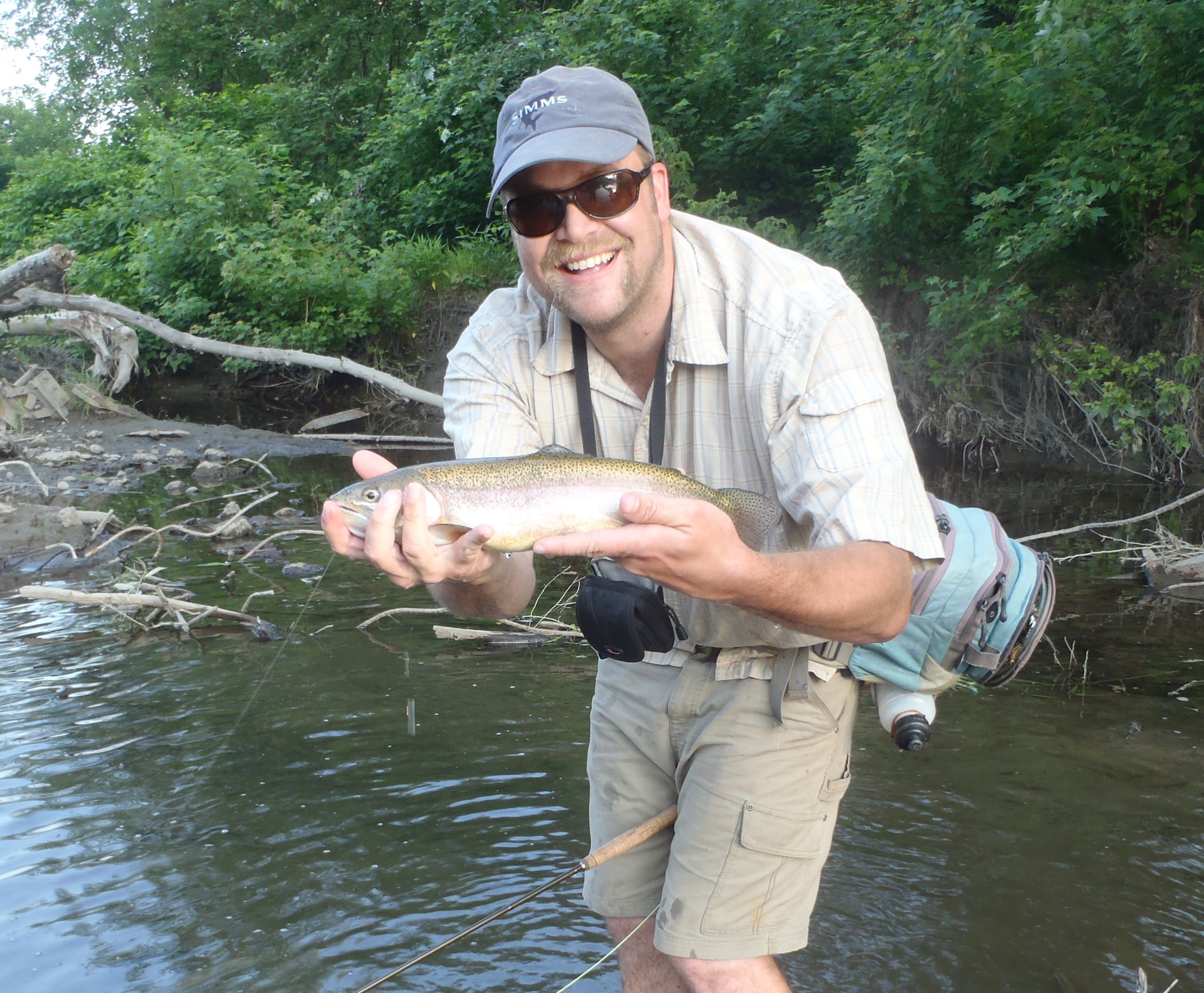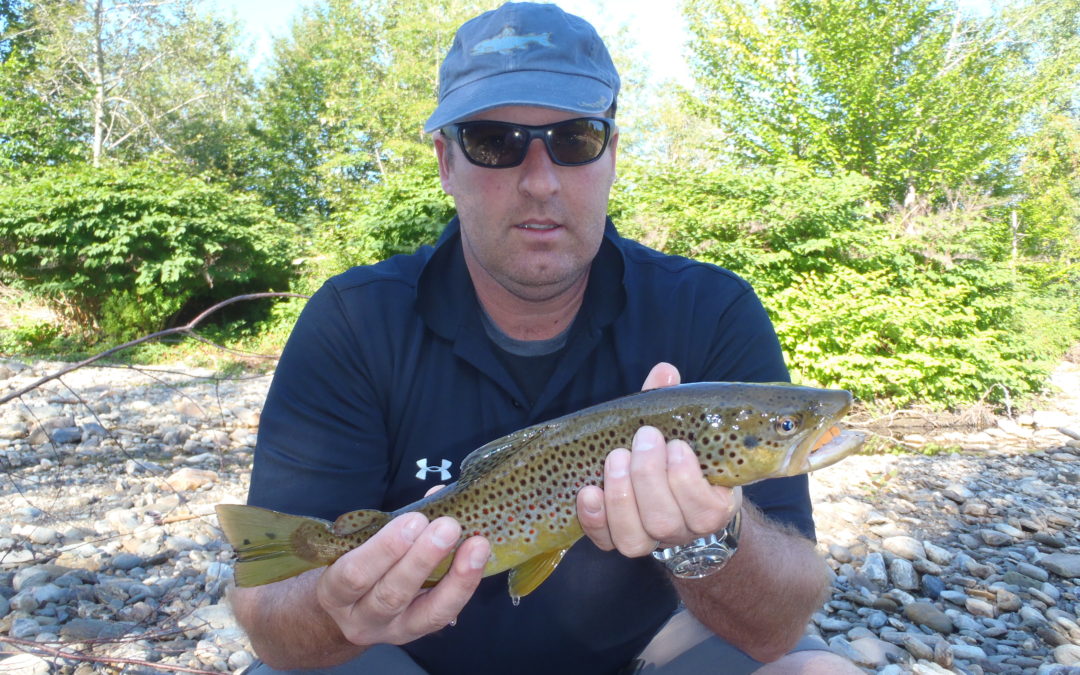Mid summer conditions can give fly fishermen a number of challenges. You will likely find low water, warm water, and perhaps less reliable aquatic insect hatches during the dog days of summer, but don’t lose faith. There are a few things you can do to stack the odds in your favor. Understanding how conditions effect the fish and learning how to fly fish with terrestrials will help you stay in the fish all season.
First lets address water temperatures. Water temperatures are important for any fisherman to pay attention to. They help us to understand where fish are more likely to be holding, how active they may or may not be, foods that may be available, and if it is even ethical to fish and practice catch and release. In most cases water that is between 55 degrees Fahrenheit and 65 degrees is ideal for trout fishing here in Vermont as well as most other places. Unfortunately on many rivers in this area we sometimes see water temperatures climb into the seventies during July and August. Once the water hits 70 degrees and warmer, practices of catch and release trout and salmon fishing should be halted, as the chances of successful recovery of the fish drop drastically. However bass fishing can still be productive and ethical catch and release can still be practiced.
So with warm water temps many factors begin to change. For starters, trout will seek more oxygen rich water, as oxygen levels throughout the river are lower in warmer water. Making places like cold water inlets, spring holes, steeper gradient riffles and pocket water, and shaded areas, prime locations to find mid and late summer trout. Also aquatic insect hatches tend to drop off on many bodies of water. Though hatches may still occur, they are often far less significant than they were only a few weeks ago. Low water is usually a factor this time of the year as well. This will tend to keep the fish on edge and make them a little more easily spooked.
Based on my previous statements, it would make sense to carry along a stream thermometer and monitor the water temp periodically. This will help you to decide if trout fishing is a good option, or if your efforts should be steered toward bass. You will usually find the water is the coolest in the morning keeping the fish active for a longer duration than the evening. However, with aquatic insect hatches becoming more minimal, there are other food sources becoming available at less desirable times of the day. In turn changing how the fish think and when they eat. Enter the terrestrial life forms. These include but are not limited to… grasshoppers, ants, beetles, crickets, inch worms, caterpillars, mice, and a number of other life forms that become a staple in a fishes diet at this time of the year. These critters do not hatch from the water, but due to their abundance and daily travels, some will end up in the water and become a desirable meal to a nearby fish.
When fly fishing terrestrials, the most common flies we use generally revolve around grasshoppers, ants, and beetles. This is with good reason as these are more prolific and therefore offering a reliable food source to the fish. However, don’t be afraid to try lesser used patterns like inch worms, crickets, or whatever else you may have kicking around in your terrestrial box. Since this is an opportunistic bite, often one will work as well as the next and pressured fish may be more willing to bite as they may have already seen every grasshopper pattern under the sun. Another fun pattern to try is mouse flies. They usually will work best under low light or the cover of darkness and are a great way to find trophy fish.
Terrestrial insects tend to be most active during the heat of the day. Usually from about the time the sun starts to warm the ground and evaporates the morning dew, through late afternoon. Again making paying attention to water temperature all the more important for the safe handling of trout. The terrestrial bite is generally a sporadic one as they randomly end up on the water, but the fish are suckers for them. This makes these patterns great for searching. Also, taking a pattern such as a grasshopper, Chernobyl ant, or other hard to sink patterns, and suspending one or two nymphs under it is another great method. This allows you to fish throughout the entire water column with each drift and perhaps persuade some of the less active fish into taking an easy meal.
The one exception to the rule of terrestrials presenting themselves sporadically is the flying ant hatch. Here in Vermont we generally encounter the flying ant hatches toward late August and early September. They hatch so abundantly that they will at times blanket the water. This is a great after work hatch. You will know when they are coming off because during your afternoon commute home, your windshield will turn into a bug spattered mess. So be sure to keep your gear with you, as the don’t come off every day, and the fish love them.
Lastly, because the water flows are often low this time of the year, try to fish the upstream quadrant when possible. This will keep you downstream of the fish and reduce the odds of spooking them before making your first presentation. Hopefuly fly fishing terrestrials will give you a little different perspective on fishing the dog days of summer and make your time on the water a little more productive. Josh


